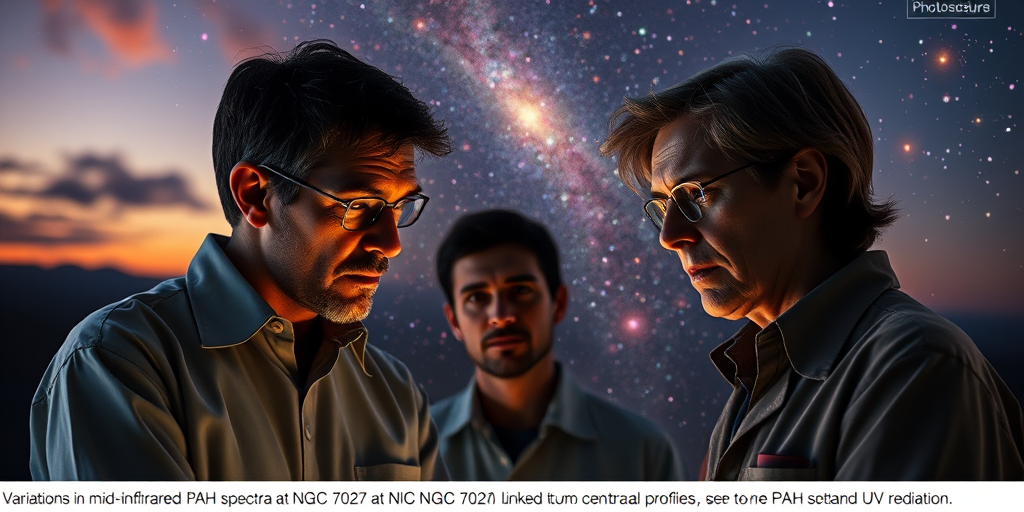Astrobiology Breakthrough: Polycyclic Aromatic Hydrocarbons Unveiled in NGC 7027
Discovering the Diversity of the Universe: An In-Depth Look at PAH Spectral Diversity
In a remarkable study, researchers led by Charlotte Smith-Perez have unveiled intricate details about the diversity of Polycyclic Aromatic Hydrocarbons (PAHs) within NGC 7027, a planetary nebula. Utilizing the James Webb Space Telescope’s Mid-Infrared Instrument Medium-Resolution Spectrometer (JWST MIRI-MRS), this research marks a significant step in understanding the complexity of aromatic carriers in cosmic environments, a subject of particular interest for both professionals and enthusiasts in astrochemistry.
Illuminating the Complex Nature of Aromatic Carriers
Polycyclic Aromatic Hydrocarbons (PAHs) are complex hydrocarbons that constitute a significant portion of the cosmic carbon cycle and dominate mid-infrared spectra in various astrophysical settings. The study constitutes a part of a broader effort to unravel the transition of pristine hydrocarbons and PAHs in circumstellar environments to those observed in the interstellar medium (ISM). Through the innovative use of spectral cubes from the JWST MIRI-MRS, researchers provided a detailed examination of the mid-infrared PAH spectra spanning 5-18 microns within NGC 7027.
NGC 7027, a planetary nebula, became the focal point of a groundbreaking exploration that revealed spatially-resolved variations across various PAH spectral profiles, classified as A, AB, and B, spanning the major PAH bands of 6.2, 7.7, 8.6, and 11.2 microns. This differentiation is pivotal, as each class exhibits specific behavioral patterns with proximity to the nebula’s central star.
Groundbreaking Revelations
The study’s findings highlight a compelling correlation between PAH profile classes and proximity to the central star’s ultraviolet radiation, suggesting that the molecular processing varies dramatically across different PAH classes. Specifically, class B PAHs appear to represent a more processed state, while class A PAHs remain relatively pristine, challenging traditional notions about the spectral evolution of PAHs.
By shedding light on the significant correlations among the 6.2, 7.7, and 8.6 micron bands, and observing associations within the red (6.26, 7.8, 8.65 micron) and blue (6.205, 7.6 micron) components, researchers have highlighted the complexity of these molecules. Notably, the study noted that the blue component of the 8.6 micron band appears independently, suggesting diversity in the molecular structure of PAH subpopulations.
Furthermore, the decomposition of the 11.2 micron band reaffirmed the presence of two identifiable components, attributing the broader 11.25 micron element to emissions from very small PAH grain clusters, rather than PAH emissions per se.
Continuing the Cosmic Narrative
Astrobiology Web, a comprehensive resource in astrochemistry, interlinks this study with other significant discoveries that provide pivotal insights into cosmic phenomena. These include the first detection of molecular activity in the largest known Oort Cloud comet, C/2014 UN271 (Bernardinelli–Bernstein), and the discovery of life’s building blocks in ice surrounding a forming star in a neighboring galaxy.
Keith Cowing, a distinguished space biologist and journalist, emphasizes the value of such findings, noting that “understanding the universe’s complex chemical evolution is key to revealing answers about life’s origins.” This study’s focus on aromatic carriers aligns with other high-impact research by Cowing, contributing to a deeper understanding of cosmic molecular evolution and its implications for the solar system’s formation.
Implications for the Local and Global Communities
While these discoveries in space technology and astrochemistry might seem distant to some, they resonate significantly with local communities and the scientific community at large. For researchers and residents in places like Houston, home to the NASA Johnson Space Center, such studies contribute to ongoing projects exploring cosmic environments and the origins and evolution of life.
These findings also resonate with the broader educational narrative, providing local schools and universities with cutting-edge content to inspire and educate students about the possibilities within the field of space sciences. By connecting complex scientific research to tangible events and discoveries, educators can spark interest and enthusiasm, paving the way for future leaders in diverse scientific domains.
The Road Ahead: New Directions and Challenges
The research into PAH spectral profiles in NGC 7027 demonstrates the complexity and dynamic nature of cosmic environments. As we move forward, continuous exploration and technological advancement are essential in addressing these challenges and unraveling more cosmic mysteries.
Astrobiology Web, through its array of resources, including educational opportunities and access to breakthroughs in astrochemistry, fosters a collaborative environment for sharing advancements and fostering community interest. As new knowledge about aromatic carriers and cosmic chemistry unfolds, the path toward understanding our universe—and our place within it—becomes ever clearer and more promising.
Residents, researchers, and students interested in learning more about this groundbreaking research can visit Astrobiology Web for in-depth articles, discussions, and educational resources that illuminate the evolving landscape of astrobiology.







